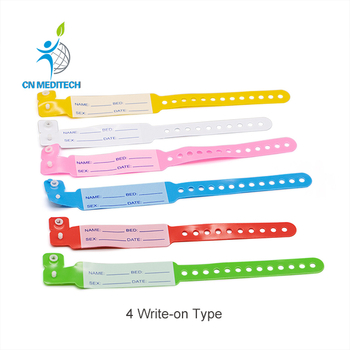Just How Patient Identification Band Improves the Overall Patient Experience in Medical Facilities
Just How Patient Identification Band Improves the Overall Patient Experience in Medical Facilities
Blog Article
Patient Identification Bands: A Key Tool for Improved Medical Accuracy
Patient identification bands stand for a vital element in the search of clinical accuracy and patient security within healthcare atmospheres. The real degree of their impact on individual outcomes and overall health care high quality warrants even more assessment.

Significance of Client Identification
Person identification is a vital component of healthcare that makes sure the safety and precision of medical treatment. Proper recognition methods are vital to avoid clinical mistakes, which can lead to negative client outcomes, consisting of incorrect drug management, misdiagnosis, or unacceptable therapy plans. The significance of exact individual recognition can not be overstated, as it works as the structure for efficient communication among health care carriers.
In atmospheres where multiple people are receiving therapy simultaneously, the threat of identity confusion increases. Implementing durable identification systems assists minimize these threats and boosts client safety and security. Patient Identification Band. Precise identification adds to the integrity of medical records, guaranteeing that individual backgrounds, allergic reactions, and previous therapies are correctly linked to the right person.
Additionally, conformity with regulatory criteria and accreditation needs commonly mandates stringent patient recognition procedures, fostering a culture of responsibility and top quality care. Eventually, the relevance of patient identification goes beyond simple management jobs; it is a fundamental aspect of providing premium health care that focuses on client safety and security and improves medical results. Buying effective recognition practices is not just useful-- it's imperative in today's facility medical care landscape.
Kinds Of Client Identification Bands
In health care setups, various kinds of person recognition bands are made use of to make certain precise identification and improve security. These bands function as a critical tool in avoiding medical errors connected to client misidentification.
The most typical type is the typical wristband, typically constructed from sturdy plastic and published with the person's name, date of birth, and a distinct identification number. These wristbands are often color-coded to communicate specific details, such as allergic reactions or various other medical problems.
One more type is the barcode wristband, which incorporates a scannable barcode linked to the patient's electronic wellness document. This modern technology enables for efficient information access and confirmation during medication management and other professional processes.
Additionally, RFID (Radio Regularity Identification) bands are becoming progressively prominent. These bands can communicate wirelessly with health center systems, permitting for real-time monitoring and identification of individuals, thus improving and streamlining process patient security.

Advantages for Healthcare Companies
Making use of person recognition bands offers substantial benefits for healthcare providers, improving both functional efficiency and patient safety and security. These bands offer as a vital tool in enhancing individual management procedures (Patient Identification Band). By ensuring exact identification, doctor can decrease the threat of administrative errors, such as mislabeling examples or misdirecting treatments, which can lead to pricey hold-ups and issues
Moreover, individual identification bands help with seamless communication amongst the health care group. With readily available and standard client information, suppliers can make educated decisions rapidly, improving total workflow. This effectiveness is particularly important in high-pressure settings such as emergency situation divisions, where time-sensitive interventions are important.
The application of identification bands also sustains compliance with governing standards and best practices, thereby minimizing the threat of lawful consequences stemming from identification errors. Furthermore, the usage of these bands enhances information accuracy in electronic health and wellness documents, causing much better care coordination and connection.
Effect On Client Security
Exact individual identification is a foundation of healthcare safety and security, significantly decreasing the chance of mistakes that can endanger client health. The use of client recognition bands is vital in making sure that each person receives the right therapy, medications, and procedures. These bands function as a reliable recommendation factor for you can try here medical care specialists, lessening the threat of misidentification, which can result in major consequences such as incorrect medication management or surgical errors.
The implementation of standard person recognition bands contributes to a culture of safety and security within health care settings. By providing clear, conveniently readable info, these bands assistance to reinforce the value of confirming patient identity at every stage of treatment. Moreover, they help with communication amongst employee, ensuring that every person associated with a patient's treatment is conscious of their particular requirements and requirements.
Additionally, utilizing individual identification bands can improve the accuracy of digital health documents, better minimizing the possibility for errors - Patient Identification Band. By prioritizing person security via effective recognition techniques, doctor can promote trust and self-confidence amongst people, inevitably resulting in better clinical results and find more info boosted patient satisfaction. The impact of appropriate person identification can not be overstated; it is a basic element of high-quality healthcare distribution
Ideal Practices for Execution
Reliable application of patient recognition bands is essential for improving individual safety and minimizing errors in medical care setups. Team training is crucial; all group participants need to understand the relevance of precise patient recognition and the procedures for band application.
2nd, the style of the identification bands need to prioritize presence and toughness. Bands must be simple to read, include necessary patient information, and stand up to day-to-day wear. Using color-coding can better enhance fast recognition.


Third, incorporating electronic health documents (EHR) with recognition band systems can improve process. Automated alerts for inconsistencies in client identification can stop prospective errors before they occur.
Last but not least, carrying out regular audits and comments sessions will certainly aid recognize areas for renovation. Involving personnel in these conversations promotes a culture of security and accountability.
Verdict
In verdict, individual recognition bands play an important duty in boosting clinical accuracy and guaranteeing person security within health care systems. Adopting ideal methods for application promotes a society of safety and security, inevitably leading to improved patient end results and greater trust in healthcare services.
Patient identification bands represent an important part in the pursuit of clinical accuracy and client safety within continue reading this health care settings.Utilizing person recognition bands provides significant benefits for health care companies, improving both operational effectiveness and client safety. By focusing on individual security through reliable recognition methods, healthcare service providers can foster trust fund and confidence amongst individuals, ultimately leading to far better medical results and improved person fulfillment.Reliable application of patient recognition bands is important for enhancing person security and reducing mistakes in healthcare settings.In verdict, client identification bands play a critical role in boosting medical precision and making sure patient safety within health care systems.
Report this page